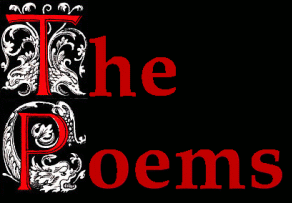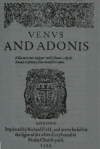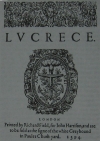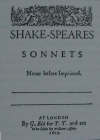



Note: This is obviously preliminary, even as an appendix, but procrastination has left this off for so long that I attempt to force its hand by making this available now. I hope to add more later.
The poems generally attributed to Shake-speare comprise a diverse group. It is difficult to see any kind of development over time with them as can be done with the plays because the dates are largely unknown. His first two public poems, Lucrece and Venus, are fairly reliably dated to the years 1593 and 1594. After that, it is much harder to say. The Sonnets may represent a range of years, say ten years or more, and there is no guarantee that the order of the Sonnets as we have received them is the order in which they were written. The dating of the few remaining poems is, perhaps, even more difficult. And, with the exception of Lucrece and Venus, it is even hard to comment on the subject matter of the poems. In short, I have little to say, and I am not about to interpret the poems. What I briefly comment on below are some of the externals regarding the known circumstances of publication of the poems and how that may connect to William Stanley. In the case of the Sonnets, I focus on the few most likely references to the author himself.


 Venus and Adonis and The Rape of Lucrece
were dedicated to Henry Wriothesly, the earl of Southampton.
That Wriothesly (mercifully, pronounced ROSE-lee) and Derby knew each other is known and
not at all surprising, both being earls. At the time of the
publication of Venus, however, William was not an earl,
nor did it look like he would become one, as the position was
held by his only slightly older brother. By the following year,
when Lucrece was registered, his brother had died and he had become an earl.
Many commentators have struggled to explain the more familiar
tone of the dedication of the second poem, and suggest Shakspur
had become an intimate of Southampton's circle. With Derby
as Shake-speare, it simply becomes the correct tone of a peer,
at the correct time.
Venus and Adonis and The Rape of Lucrece
were dedicated to Henry Wriothesly, the earl of Southampton.
That Wriothesly (mercifully, pronounced ROSE-lee) and Derby knew each other is known and
not at all surprising, both being earls. At the time of the
publication of Venus, however, William was not an earl,
nor did it look like he would become one, as the position was
held by his only slightly older brother. By the following year,
when Lucrece was registered, his brother had died and he had become an earl.
Many commentators have struggled to explain the more familiar
tone of the dedication of the second poem, and suggest Shakspur
had become an intimate of Southampton's circle. With Derby
as Shake-speare, it simply becomes the correct tone of a peer,
at the correct time.
There is another connection between these two men that took place that year, for William Stanley married Elizabeth de Vere, the daughter of the earl of Oxford. She had been proposed to Wriothesly, as things were done in those days, and Wriothesly paid a fine for refusing to marry her.

Shake-speare's The Phoenix and the Turtle appears in a collection of poems appended to Robert Chester's Love's Martyr, itself a hodgepodge based loosely on the idea of the Phoenix, the mythical creature that self-immolates only to rise anew from its own ashes.
Shakes-speare's poem is highly regarded, profound, and needs no external reference to make it work, yet many attempts have been made to identify historical personages with Shake-speare's (and the entire compilation's) characters of the phoenix and the turtle (dove). None of these has been widely accepted but perhaps someday a consensus will emerge supporting one of the current theories or a new one.
The only definite connection the poem has to history is its inclusion in this compilation, an investigation into which proves interesting. It may not surprise the reader by this time, that the few facts we know about the circumstances of this poem most closely associate it with William Stanley, of all candidates, by far.
Love's Martyr is dedicated to Sir John Salusbury, a relatively minor but rising member of the nobility. Why would a rare poem by Shake-speare, and poems by Marston and Jonson, appear in this collection? Stratfordians sometimes suggest that Shakspur was looking for or rewarding a patron, but recognize that there is no evidence for this. Yet, as Who's Who in Shakespeare's England [1] puts it:
[Salusbury] knew Marston and Jonson and probably Shakespeare, too
But one must not be led to believe that there is any evidence that Salusbury knew Shakspur. And can any candidate even begin to approach Derby's connection?
Salusbury was closely connected to William Stanley by marriage, because Salusbury's wife was William's half-sister Ursula. Stanley grew up with Ursula, literally in the same house. In a surviving letter of William Stanley's, Stanley addresses his brother-in-law John Salusbury and his half-sister Ursula as his "lovinge brother" and "good sister".
Ursula was the daughter of Joan Halsall, and she was fathered by William's father, Henry. Henry openly acknowledged his extra-marital relationship with, and children by, Joan Halsall.
Stanley and Ursula remained close. For example, in 1597, near the time of this poem, Derby and his wife visited Salusbury and Ursula at their home in Lleweni, where they were "very royally entertained". [2]
Carleton Brown [3] has investigated the connection between Robert Chester and Sir John Salusbury, and discovered in the Salusbury papers many poems, most written by Robert Chester and Salusbury himself. Several of the poems contain acrostics referencing Chester's and Salusbury's acquaintances. (These acrostics are standard word games in which, for example, someone's name is spelled out by taking the first letter of each line in a poem. These are easily seen and universally recognized. They are not to be confused with the purely subjective cryptograms that have so embarrassed the Baconian position.) In love poems identified as Salusbury's, the name that most frequently appears in the acrostics is that of Dorothy Halsall.
Brown writes:
in the lyrics addressed to [Dorothy Halsall] a warmth of passion appears which suggests that Sir John found her a thoroughly fascinating person. Dorothy was the natural daughter of Henry Stanley, fourth earl of Derby, by Joan Halsall of Knowsley [William Stanley's home], and was accordingly a sister-in-law of Sir John Salusbury.
So Dorothy, like Ursula, was another daughter by Joan Halsall and Henry Stanley, who also lived at the Derby estate of Knowsley (Dorothy kept the Halsall name while her sister Ursula adopted her father's, Henry Stanley). [4]
Gililov and his researchers discovered something astonishing about the history of the available copies of this work. Even though there appears to be a first edition, dated 1601, there is what has always been presumed to be a second edition, dated 1611. But the fact noticed by Gililov et. al. is that the paper used in printing both editions has the same watermark. As Gililov points out, it is highly unlikely that the same paper would be used ten years later, when other documents by the same printer did not use it.
The point being that, quite likely, there is a subterfuge occuring here, and that the dates are deliberately evasive. But why? And here, I think, comes Gililov's startling and presuasive surmise:
He suggests that Shake-speare's poem about The Phoenix and the Turtle is about Rutland and his wife, the daughter of Philip Sidney. Suddenly, ideas in the poem, and the collection in general, make sense. There really was a chaste couple and this really is a funeral dirge for them. Rutland and his wife, celibates, died almost together, just before the date of the "second edition". That his wife committed suicide may well be the cause of the general silence regarding the astonishing facts, but Shake-speare, Jonson, and Marston were enabled by this curious conglomeration of "Robert Chester" for Sir John Salusbury, to publish (publically unregistered) praise for the couple.
I refer you to the book about this. But regarding the Rutland-is-Shake-speare theory, I am completely unconvinced. It is not until the last two pages of his 500 page book that Gililov addresses the obvious problem that Shake-speare has written (if his theory is correct) a funeral dirge for himself, referring to the details of his death (and his wife's which he could not have known). Gililov proposes that the Phoenix and the Turtle, in which the subjects are dead is not the work of Shake-speare(/Rutland), and that the poems in the collection that are clearly marked as from the Turtle-Dove (Rutland) to his Phoenix (Sidney), in which the subjects are alive, are from Shake-speare(/Rutland). I think he has pushed a genuine discovery too far. He must require that a generally accepted Shake-speare work is not by Shake-speare and that generally unaccepted works are by Shakespeare. I think it obvious that Shake-speare wrote The Phoenix and Turtle, and based on Gililov's remarkable work, we now know it concerns the Earl of Rutland and Elizabeth Sidney. What we learn in addition is that Rutland wrote the accomplished acrostic poems to his wife that are identified to the Phoenix from the Turtle in this collection, and this makes perfect sense with their content.
While I think that the assignation of the subject is a remarkable breakthrough in Shake-speare studies regarding The Phoenix and the Turtle, I don't think the Rutland candidacy is advanced by the theory or by the additional requirements/speculation. But it seems unlikely the correct identification of the subjects of the work would have ever been discovered without the Rutlander Gililov's efforts.



 The Sonnets have been extensively analyzed and variously interpreted.
They remain obscure, except to the proponents of the individual
interpretations who claim to find great clarity in their unique
interpretations. The poems seem deliberately written to afford
multiple interpretations, and to base any authorship argument on an
idiosyncratic interpretation of them seems to me ill-advised.
Neither the situations or characters described in them have
been identified to my satisfaction or to any general acceptance.
The Sonnets have been extensively analyzed and variously interpreted.
They remain obscure, except to the proponents of the individual
interpretations who claim to find great clarity in their unique
interpretations. The poems seem deliberately written to afford
multiple interpretations, and to base any authorship argument on an
idiosyncratic interpretation of them seems to me ill-advised.
Neither the situations or characters described in them have
been identified to my satisfaction or to any general acceptance.
I could, of course, find parallels in Derby's life to interpretations of the Sonnets, just as I could do for the plays. But that is an easy exercise (for virtually any candidate), and it is always unconvincing. As I believe I have said before, even when the author of a work is known, to point out particulars in the author's life as evidenced in the author's work is rarely satisfactory. To use it as a means of establishing the identity of the author is very weak.
That said, I do think the Sonnets describe actual experiences of the poet, unlike some commentators who consider them purely imaginary. I think the author tells us he was lame, his name was Will, and perhaps that he carried the canopy over the Queen in some ceremonial. Regarding the last (sonnet 125), if that is the correct interpretation, it only restricts the possibilities to members of the nobility.
More directly, Shake-speare twice tells us that he was lame (sonnets 37 and 89). We know from his letters that Oxford was lame, and that is a point in favor of Oxford's authorship. The author also tells us that his name was Will in at least one sonnet (136), and that is a point in Derby's favor.
In short, I think it more likely that Derby was lame than that Oxford was named Will, but in general the indications are at present too vague to say much more. [2]


Notes on The Phoenix and the Turtle
For further evidence of the close association of Salusbury and Stanley, the following comes from a footnote in Matchett's The Phoenix and the Turtly where he is discussing just this close relationship:
One might note in the names of the children...that Salusbury named his first two sons Henry (the first having died shortly after birth), his father-in-law's [i.e., William Stanley's father's] name. Then after two John's and a Francis, in 1595 came William, the name of his brother-in-law, who had become the sixth Earl of Derby in 1594. In 1599 came Ferdinando, name of his older brother-in-law, who was so briefly the fifth Earl.
A letter from Richard Broughton, dated "Ludlow v: Mch" without the year. Judging by earlier letters, Broughton was close to the Derby household and, since he calls Salusbury "cousen", he was probably related to Salusbury's wife. The long letter—which sounds so like Justice Shallow that only with difficulty do I resist quoting its irrelevancies in full—...Matchett considers it irrelevant because he is only after information concerning Salusbury's connections to Essex, and quotes briefly from the letter concerning that. But perhaps, albeit unknowingly, he has discovered the source of Justice Shallow?
Also, if Broughton "was probably related to Salusbury's wife", he was probably related to William Stanley. Non-sibling relationships were frequently referred to as "cousin". Perhaps we have in 2 Henry IV an in-family joke:
SHALLOW: By yea and nay, sir, I dare say my cousin William is become a good scholar: he is at Oxford still, is he not?William Stanley was at Oxford prior to attendance at Gray's Inn and, later, Lincoln's Inn.
SILENCE: Indeed, sir, to my cost.
SHALLOW: A' must, then, to the inns o' court shortly.
("A' must" means "He must".)
Notes on The Passionate Pilgrim
(See also my note on some lines of Marston where he apparently refers to Shake-speare as a Knight of the Garter and lame.)
